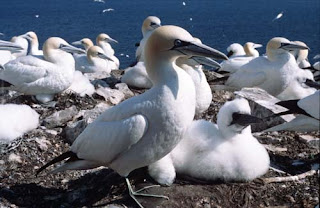 Researchers at the
Researchers at the In a paper published in Marine Ecology Progress Series, Dr Keith Hamer of the University’s Faculty of Biological Sciences reports that diminishing fish stocks around the birds’ natural habitats – caused partly by an increase in sea temperature – are forcing them to search further afield for food for their young.
“Usually, one parent will stay with a chick while the other goes out hunting,” said Dr Hamer. “But if left for long enough, it will eventually leave the nest itself to find food. This leaves the chick alone and vulnerable to attack - mainly from other Gannets seeking prime nesting space, which is fiercely contested within colonies.”
Two thirds of the world’s Gannets nest in the
“Gannets have been forced to travel as far as the Norwegian coast to find food – a round trip of over 1,000 km,” said Dr Hamer. “They compensate by flying faster to make sure they don’t leave their nests for too long, but our research shows they’ve hit their limit. They just physically can’t increase their speed any further.”
Until now, Gannets have bucked the trend in the
Gannets pair for life and breed annually, occupying the same nest each year. It takes 40 days for an incubated egg to hatch and a further 90 days for chicks to fledge. “There’s only time for each Gannet pairing to raise one chick each year, so with an increasing number losing their chicks and their nesting sites we may start to see a decline in overall numbers,” says Dr Hamer.
* Prior to this new research being published, Gannet was one of the species tipped to decline in Des McKenzie’s article ‘Losses and gains’, published in the July 2007 climate change special issue of Birdwatch. For details of more species set to benefit or lose out through global warming, see pages 40-42 of that issue.
